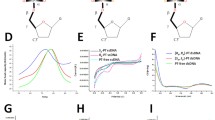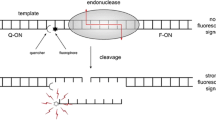Abstract
Salicylic acid and formaldehyde form heterogenous methyl/methylene salicylicacidyl oligomers and polymers in presence of sulfuric acid (H2SO4) and sodium nitrite (NaNO2). One of the oligomers as aurintricarboxylic acid (ATA), methelene bridged salicylic acid trimer, has been identified and explored in biochemical research, which is a potent inhibitor of many biological processes. A very few reports are also available on dimer, trimer, and tetramer of methelene bridged salicylic acids from same reaction mixture. Herein, we report the isolation and biochemical screening of partial purified low-molecular component as methylene salicylicacidyl hexamer (MSH) from the above reaction mixture. The interaction of methylene salicylicacidyl oligomer with DNA was studied by agarose and polyacrylamide gel electrophoresis, which suggest that methylene salicylicacidyl oligomer has DNAse activity. So far, no such significant reports are available on low-molecular oligomer of methelene bridged salicylic acids. In further, we also attempted to investigate the nature of nuclease activity, which clearly indicates DNA exonuclease type of activity. Further studies are needed to establish the mechanism of actions.

Synthesis of methylene salicylic acic (MSH) and DNAase studies




Similar content being viewed by others
References
Cushman, M., & Kanamathareddy, S. (1990). Synthesis of the covalent hydrate of the incorrectly assumed structure of aurintricarboxylic acid (ATA). Tetrahedron, 46, 1491–1498.
Cushman, M., Kanamathareddy, S., De Clercq, E., Schols, D., Goldman, M. E., & Bowen, J. A. (1991). Synthesis and anti-HIV activities of low molecular weight aurintricarboxylic acid fragments and related compounds. Journal of Medicinal Chemistry, 34, 337–342.
Gonzalez, R. G., Blackburn, B. J., & Schleich, T. (1979). Fractionation and structural elucidation of the active components of aurintricarboxylic acid, a potent inhibitor of protein nucleic acid interactions. Biochimica et Biophysica Acta, 562, 534–545.
Wang, P., Kozlowski, J., & Cushman, M. (1992). Isolation and structure elucidation of low-molecular-weight components of aurintricarboxylic acid (ATA). Journal of Organic Chemistry, 57, 3861–3866.
Gonzalez, R. G., Haxo, R. S., & Schleich, T. (1980). Mechanism of action of polymeric aurintricarboxylic acid, a potent inhibitor of protein–nucleic acid interactions. Biochemistry, 19, 4299–4303.
Kreamer, B. L., Anderson, J., Liu, D. S., Sparks, M. B., & Richardson, A. (1978). Inhibition of cell-free protein synthesis by analogues of aurintricarboxylic acid. Canadian Journal of Biochemistry, 56, 1162–1167.
Thompson, D. C., & Reed, M. (1995). Inhibition of NAD(H)/NADP(H)—requiring enzymes by aurintricarboxylic acid. Toxicology Letters, 81, 141–149.
Hung, H. C., Tseng, C. P., Yang, J. M., Ju, Y. W., Tseng, S. N., Chen, Y. F., Chao, Y. S., Hsieh, H. P., Shih, S. R., & Hsu, J. T. (2009). Aurintricarboxylic acid inhibits influenza virus neuraminidase. Antiviral Research, 81, 123–131.
Gagliardi, A. R., & Collins, D. C. (1994). Inhibition of angiogenesis by aurintricarboxylic acid. Anticancer Research, 14, 475–479.
McCune, S. A., Foe, L. G., Kemp, R. G., & Jurin, R. R. (1989). Aurintricarboxylic acid is a potent inhibitor of phosphofructokinase. The Biochemical Journal, 259, 925–927.
Novi, A. M. (1977). Aurintricarboxylic acid (ATA) and DNA synthesis. 2. Effect of ATA on structure and function of crypts of small intestine. Virchows Archiv B-Cell Pathology Including Molecular Pathology, 23, 155–162.
Nakane, H., Balzarini, J., Declercq, E., & Ono, K. (1988). Differential Inhibition of various deoxyribonucleic-acid polymerases by Evans blue and aurintricarboxylic acid. European Journal of Biochemistry, 177, 91–96.
Sharma, R. K., Chopra, S., Sharma, S. D., Pande, V., Ramos, M. J., Meguro, K., Inoue, J., & Otsuka, M. (2006). Biological evaluation, chelation, and molecular modeling studies of novel metal-chelating inhibitors of NF-kappaB-DNA binding: structure activity relationships. Journal of Medicinal Chemistry, 49, 3595–3601.
Suram, A., Hegde, M. L., & Rao, K. S. (2007). A new evidence for DNA nicking property of amyloid beta-peptide (1–42): relevance to Alzheimer’s disease. Archives of Biochemistry and Biophysics, 463, 245–252.
Ghosh, U., Giri, K., & Bhattacharyya, N. P. (2009). Interaction of aurintricarboxylic acid (ATA) with four nucleic acid binding proteins DNase I, RNase A, reverse transcriptase and Taq polymerase. Spectrochimica acta. Part A, molecular and biomolecular spectroscopy, 74, 1145–1151.
Hung, H. C., Chen, T. C., Fang, M. Y., Yen, K. J., Shih, S. R., Hsu, J. T., & Tseng, C. P. (2010). Inhibition of enterovirus 71 replication and the viral 3D polymerase by aurintricarboxylic acid. The Journal of Antimicrobial Chemotherapy, 65, 676–683.
Cushman, M., Wang, P. L., Chang, S. H., Wild, C., De Clercq, E., Schols, D., Goldman, M. E., & Bowen, J. A. (1991). Preparation and anti-HIV activities of aurintricarboxylic acid fractions and analogues: direct correlation of antiviral potency with molecular weight. Journal of Medicinal Chemistry, 34, 329–337.
Zaccagnini, G., Maione, B., Lorenzini, R., & Spadafora, C. (1998). Increased production of mouse embryos in in vitro fertilization by preincubating sperm cells with the nuclease inhibitor aurintricarboxylic acid. Biology of Reproduction, 59, 1549–1553.
Baumann, H., Hofmann, R., Lammers, M., Schimpff-Weiland, G., & Follmann, H. (1984). Aurintricarboxylic acid and polynucleotides as novel inhibitors of ribonucleotide reductases. Zeitschrift fur Naturforschung Section C: Biosciences, 39, 276–281.
Cushman, M., Wang, P., Reymen, D., Este, J., Witvrouw, M., Neyts, J., & Declercq, E. (1995). Anti-HIV and anti-HCMV activities of new aurintricarboxylic acid analogs. Antiviral Chemistry & Chemotherapy, 6, 179–186.
Blumenthal, T., & Landers, T. A. (1973). The inhibition of nucleic acid-binding proteins by aurintricarboxylic acid. Biochemical and Biophysical Research Communications, 55, 680–688.
Hallick, R. B., Chelm, B. K., Gray, P. W., & Orozco, E. M., Jr. (1977). Use of aurintricarboxylic acid as an inhibitor of nucleases during nucleic acid isolation. Nucleic Acids Research, 4, 3055–3064.
Heisig, G. B., & Lauer, W. M. (1929). Ammonium salt of aurintricarboxylic acid. Organic Syntheses, 9, 8.
Heisig, G. B., & Lauer, W. M. (1956). Ammonium salt of aurintricarboxylic acid. Organic Syntheses, 1, 54.
Caro, N. (1892). Concerning hydroxyaurins and hydroxyaurin- carboxylic acids. Chemische Berichte, 25, 939.
Acknowledgments
We are thankful to NISER and Department of Atomic Energy (DAE), Govt. of India, for providing financial support for this study.
Author information
Authors and Affiliations
Corresponding author
Additional information
Ankit Tiwari, Chandrasekhar Reddy Gade, Manjusha Dixit and Nagendra K. Sharma contributed equally to this work.
Electronic supplementary material
Below is the link to the electronic supplementary material.
ESM 1
(DOCX 630 kb)
Rights and permissions
About this article
Cite this article
Tiwari, A., Gade, C.R., Dixit, M. et al. Methylene Salicylicacidyl Hexamer (MSH) Has DNAse Activity. Appl Biochem Biotechnol 176, 1791–1800 (2015). https://doi.org/10.1007/s12010-015-1678-z
Received:
Accepted:
Published:
Issue Date:
DOI: https://doi.org/10.1007/s12010-015-1678-z




